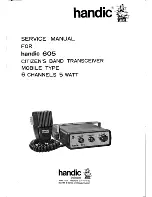
7
2.4.2 Carrying the Transceiver in a Pocket
(without vital data
detection)
If you carry the Barryvox
in a pant pocket, the zip-
per must remain closed
for the duration of the trip.
Always use a secured
pocket (see illustration). If
possible, attach the wrist
loop to your pants or
secure it around your belt.
2.5
Turning the Device On
When the main switch is moved from the OFF to the
SEND or SEARCH positions, the transceiver is turned on.
While starting, the device conducts a self-test.
The microprocessor, the antennas, the sensors, and
the display are checked. If the battery level is low,
the self-test will not run.
If the self-test is completed successfully, the display
will show «OK» and the transceiver will beep three
times.
The remaining battery level is displayed as a percentage.
If the self-test fails, an error message is displayed for
20 seconds along with an acoustic warning.
The meanings of the different error messages are
described in the chapter «Troubleshooting».
Test your Barryvox at home prior to your trip. Turn the
transceiver on and monitor the self-test and the bat-
tery level. This gives you the opportunity to replace
low batteries and have an eventual defect repaired
beforehand.
6
S e t u p
2.2
Handling the Barryvox
As all transceivers, the Barryvox contains shock-sen-
sitive ferrite antennas. Therefore, you should handle it
with utmost care!
Store the device and the carrying system in a dry
spot that is protected from extreme cold or heat and
direct sunshine.
It is recommended that you have the functionality
tested at regular intervals (see chapter «Periodic
Checks»).
2.3
Interferences
As a matter of principle, avoid having other electronic
devices (e.g. mobile phones, radios, headlamps),
metal objects (pocket knives, magnetic buttons), or
other transceivers close to your running avalanche
transceiver. The PULSE Barryvox
®
contains a magnet-
ic compass.
You should not wear clothing with
magnetic buttons! Users of pacemakers are
advised to carry the device on their right side
(adjust the length of the carrying straps).
Consult
the manufacturer’s instructions with regard to the
impact on pacemakers.
When searching, hold the device at a minimum of
50 cm away from these objects and turn off any elec-
tronic devices, if possible. It is highly recommended
to turn off mobile phones!
The Application Safety Guide of the Barryvox contains
an exhaustive list of allowed equipment as well as a
detailed list of possible limitations.
(www.barryvox.com or www.mammut.ch/barryvox)
2.4
Carrying Positions
Regardless of the carrying position, the display
should always face your body!
The detection of vital data is only possible if you
carry the device in the carrying system.
(Chapter «Triage Criteria an Vital Data»)
Before you use the device for the first time in the out-
doors, or when you decide to carry the transceiver in
a different manner, we recommend that you test the
vital data sensor (Chapter «Vital Sensor Test»).
2.4.1 Carrying System
(Recommended Carrying Position)
The carrying system has to be put on your innermost
layer of clothing prior to beginning the trip (see illus-
tration) and has to be worn on your body for the dura-
tion of the trip.
The transceiver shall always
remain covered by one layer of clothing
. The
device itself is inserted into the carrying system
according to the illustration. It should always remain
anchored to the base plate of the carrying system
using the red hook on the wrist loop.








































